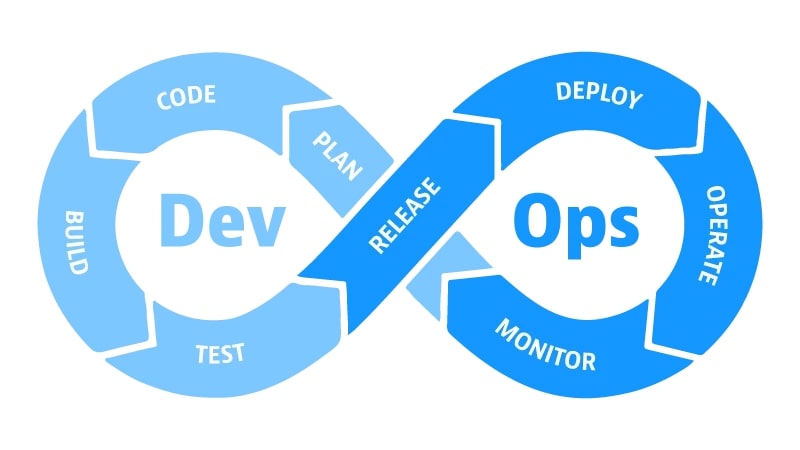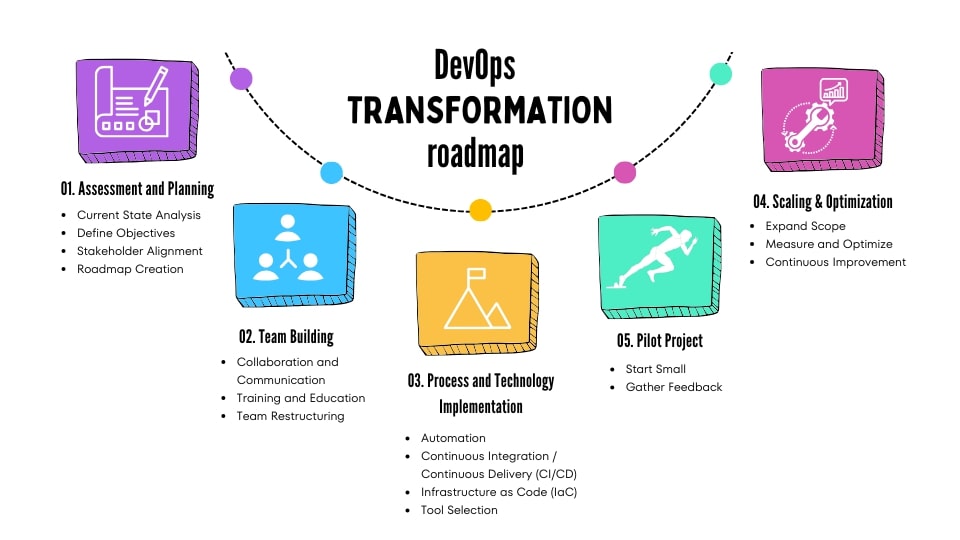Modern organizations are testing various methods to speed up their software delivery process while ensuring high quality and customer satisfaction. Among these methods, adopting DevOps has become one of the most effective strategies for bridging the gap between development and operations departments for better collaboration, flexibility, and overall improvement of the organization.
What is DevOps?

DevOps, or “development and operations,” is a set of practices and principles designed to deliver high-quality software faster and more efficiently. It connects development and IT operations teams, enhancing collaboration, communication, and automation during the software development life cycle.
This approach helps organizations achieve faster deployments, fewer errors, and a quicker response to changing market demands, making it easier to deliver reliable and scalable solutions.
DevOps transformation
DevOps transformation is when an organization shifts to the use of DevOps principles and practices. This involves cultural changes and the use of technology.
- End-to-end collaboration: DevOps forces organizations to break the barriers between development, operations, and QA teams.
- Agility and speed: DevOps helps organizations use automated testing and CI/CD pipelines to speed up their development process.
- Continuous improvement: Using monitoring tools, automated testing, and iterative feedback loops for ongoing enhancements.
However, just changing the tools won’t make a DevOps transformation within your organization. There should be a mindset shift in everyone involved in the delivery process to improve speed, efficiency, reliability, and innovation.
The goal of transforming into DevOps
Usually, the reason for transforming DevOps is that an organization wants to do things like:
- Deliver software quickly and securely without compromising quality.
- Ensure a more efficient development lifecycle.
- Satisfy end customers with speed, reliability, and high-performing solutions.
- Create an environment of continuous learning, experimentation, and collaboration.
Furthermore, a DevOps transformation helps an organization become flexible, resilient, and ready for growth in the digital age. It takes a holistic approach that combines:
- People: Teams work together, breaking down barriers between departments.
- Processes: Tools like CI/CD pipelines and automated testing speed up delivery.
- Technologies: Modern platforms like cloud services, containers, and monitoring tools support scalable and reliable systems.
Strategies for a successful DevOps transformation
A DevOps digital transformation doesn’t happen all at once. It’s a step-by-step process that requires careful planning to handle challenges along the way. Organizations should follow a clear DevOps transformation strategy like the one below to make the transition smooth and successful.
The DevOps lifecycle
The DevOps lifecycle is a continuous, repeating process that drives agility and efficiency.
- Plan and code: Collect ideas, gather requirements, and write code.
- Build and test: Compile the code and run automated tests to ensure quality.
- Deploy and operate: Release code into production and manage infrastructure.
- Monitor and feedback: Track performance, detect issues, and gather insights for improvement.
This cycle repeats itself, causing continuous feedback, quick failure repair, and iterative improvements. When a cultural shift and appropriate tools are combined, it becomes an incredible engine for agility and business growth.
Benefits of DevOps transformation
- Faster delivery: Frequent code releases help detect and fix problems early, enabling quick feature rollouts.
- Better efficiency: Automated workflows and standardized processes boost productivity and reduce disruptions.
- Improved quality: Continuous integration and testing ensure fewer defects and higher-quality releases.
- Cost optimization: Lower operating costs result in better resource utilization and savings.
- Enhanced security: Built-in security practices minimize risks and make it easier to integrate safety measures.
- Stronger collaboration: Automation eliminates repetitive tasks, promoting transparency and teamwork.
Challenges of DevOps transformation
Not only benefits, but DevOps transformation also goes along with several corresponding challenges:
- Cultural change: Moving from isolated teams to a collaborative culture requires a change in the mindset and some restructuring in the organization.
- Tool selection: Choosing the right tools can be challenging and time-consuming since there are thousands of tools available for the same purpose in today’s market.
- Legacy systems: Upgrading outdated systems to align with DevOps practices demands careful planning and execution.
- Skill gaps: Teams need training in automation, CI/CD, and monitoring to fully adopt DevOps practices.
- Continuous monitoring: Setting up robust monitoring frameworks can be resource-intensive but is essential for success.
Conclusion
DevOps is more than just a trend; it’s a key strategy for businesses to stay competitive in today’s competitive world. It helps teams speed up development, deliver better software, and adapt quickly to changes. Although there are challenges, the long-term benefits, like better performance, efficiency, and value, make DevOps a smart investment for any organization.

